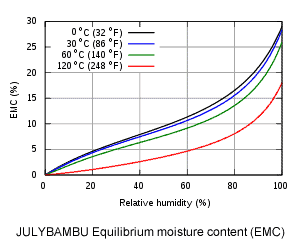Bamboo is hygroscopic, as is all wood. This means that wherever there is moisture – even in the air – the bamboo will absorb it. If the air dries out the moisture will be “drawn” out of the bamboo. This results in a dimensional change of the bamboo.

When this happens, the bamboo will either expand or contract. The force at which this movement occurs can be astounding – we have heard of wood pulling Rawl bolts out of concrete. It is for this reason that we need to keep this dimensional change in mind in our designs.
So, let’s look at how to calculate this dimensional change of bamboo so that you can compensate for it in your projects.
Some basics first
The bamboo fibers, that make up the bamboo culm, run along the length of the culm. These fibers are typically longer than the fibers found in wood (thus the incredible tensile strength of bamboo).
These fibers allow the “sap” that feeds the tree to move freely up to the leaves. The fibers are loaded with “sap”. When the bamboo culm is cut down, these fibers begin to dry out and the bamboo starts to shrink. This shrinking happens mostly in the thickness of the fibers. A very small amount of shrinkage occurs along the length.
This shrinkage is characteristic of all wood.
Fiber saturation point
These fibers have a moisture content of between 0% (completely dry) and a maximum of 25-30%. This is commonly referred to as moisture content (MC). In the wood drying process, a state is reached which is referred to as the fiber saturation point. This is the point where only water bound in the cell walls remains – all other water, called free water, has been removed from the cell cavities.
Bamboo is normally dried to a point where it is in equilibrium with the atmospheric moisture content or relative humidity. Typically, this moisture content (MC) is around 8%. Most timbers are kiln dried to between 6% and 15% before milling.
Equilibrium moisture content (EMC)
The equilibrium moisture content (EMC) is the moisture content at which the wood is neither gaining nor losing moisture; this, however, is a dynamic equilibrium and changes with relative humidity and temperature.

